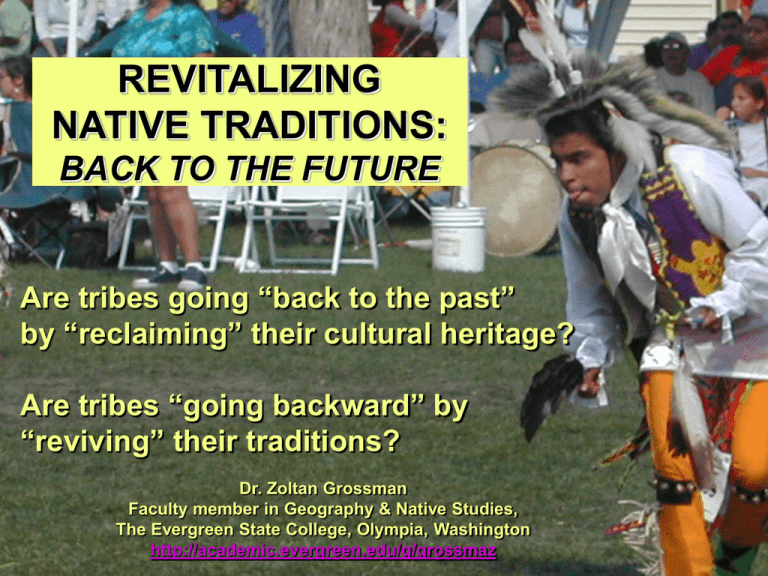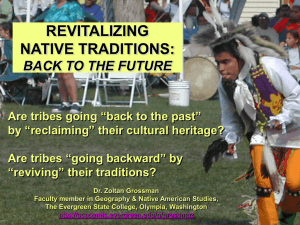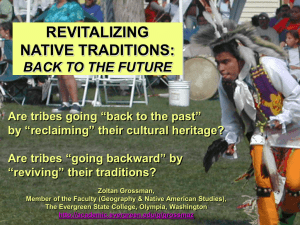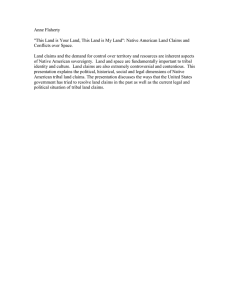REVITALIZING xxxx NATIVE TRADITIONS: BACK TO THE FUTURE
advertisement

REVITALIZING xxxx NATIVE TRADITIONS: BACK TO THE FUTURE Are tribes going “back to the past” by “reclaiming” their cultural heritage? Are tribes “going backward” by “reviving” their traditions? Dr. Zoltan Grossman Faculty member in Geography & Native Studies, The Evergreen State College, Olympia, Washington http://academic.evergreen.edu/g/grossmaz Model of Linear “Progress” Past Present “Going backward” “Reclaiming past” Future A Tale of Two Birds 1. Chickaloon, Alaska “STUPIDCHICKEN” “STUPIDCHICKEN” A Tale of Two Birds 2. Muscoda, Wisconsin A Tale of Two Birds 2. Muscoda, Wisconsin 1,300-foot wingspan Ghost Eagle in Wisconsin River Valley A symbol & allegory of Native survival and continuity xxxxx Continuity of stories Ho-Chunks’ Red Horn legend in Gottschall rock shelter Continuity through the “Dark Ages” • After suppression of Native culture and before modern revival • Little awareness of Native history from 1890s to 1960s Wounded Knee massacre, 1890 Wounded Knee siege, 1973 Continuity through the “Dark Ages” • Boarding schools assimilated youth • Reservation land allotted • Off-reservation harvesting banned • Religions outlawed • Languages repressed Yet cultures practiced in secret, survived and adapted….. Frozen in time? Edward Curtis photo in a Piegan Lodge, 1910 Spearfishing Lac du Flambeau = “Lake of the Torch” Motorboats, halogen lamps, metal spears Birchbark canoes, torches, wooden spears State outlawed treaty spearfishing in 1908 but Ojibwe practiced secretly Wisconsin Walleye Wars, 1986-92 Ojibwe treaty rights rights upheld, 1983. Anglers protest spearing as harmful (yet only 3% of walleye) Criticize technology as “nontraditional” (not in use at time of treaty) Makah whale hunting 1855 Treaty recognized importance of whaling to ancient Makah sea culture. Non-Indian commercial whaling depleted grey whales, 1920s (Recovery in 1980s) 1997 agreement for non-commercial Makah harvest 5 out of 20,000 grey whales Washington Whaling War, 1999 Save a Whale Harpoon a Makah Animal rights groups join anti-Indian groups to protest harpooning/ shooting of one whale. (Rifle brought quicker death). Gaming as nontraditional? Casinos in U.S. cash economy Gunpowder and fireworks from the Chinese Western culture constantly adopts and adapts to new technologies Clocks from the Germans Why do only Native Peoples have to be museum pieces? Christians? Americans? Right to bear arms ? Living, evolving cultures, not resurrection of dead cultures xxxx xxxx “New traditions”: Jingle Dance xxxx Cultural Mixing xxxx Grand Entry Flag Song Traditions of Governance (Cornell) • Does modern tribal government resemble older traditional form? • Trouble if decentralized before, but centralized today, etc. • Tribes with successful economic development followed precolonial government form (e.g., Pueblos) • Start of a “Native Renaissance”? Greco-Roman Era Italian Renaissance ( = “Rebirth”) Reconstituted culture: Drawing from the past, but different from the past Negation of the negation (Hegel) Past Negation of past Negation of negation Moving forward to a reconstituted culture. (Closest idea that Western thought has to Indigenous circular thinking.) “Tradition” • Not about technology but consciousness • Not about form but substance • Not about appearances but values Native Renaissance Applyingxxxx past values to present problems to build a better future “Miner’s Canary” analogy By Felix Cohen, 1953 (Modern founder of federal Indian law) “The Indian plays much the same role in our American society that the Jews played in Germany. Like the miner's canary, the Indian marks the shift from fresh air to poison gas in our political atmosphere; and our treatment of Indians, even more than our treatment of other minorities, marks the rise and fall of our democratic faith.” “Greenhouse” analogy Tribes are in a position to apply their traditional values to solve 21st-century problems • Reservations at least partly shielded by tribal sovereignty, federal trust relationship • Can “grow” their own forms of social organization and environmental sustainability • Can develop solutions that benefit Native and non-Native communities alike. Wisconsin Anti-Mining Alliance, 1993-2003 Mining companies threatened fish, wild rice Sportfishing groups joined with tribes to fight Crandon mine Two tribes defeated plan by purchasing mine site Continuing Native traditions & sovereignty benefited non-Indians too “Greenhouse” analogy Reservations as “testing grounds” for new ways of relating to the land • Sustainable Development – Land purchases; put into trust for projects – Stables, Deer farms, Organic farms, etc. • Tribal policies – EPA “Treatment-As-State” status – Gaming enables technical/legal environmental work “Greenhouse” analogy Reservations as “testing grounds” for new ways of relating to people • Development from gaming on some rezes; Reverse migration from cities for new jobs • Slow reversal of festering poverty & inequality • Tribal employment for non-Indians “Greenhouse” analogy Not just casino money, but also cultural resurgence • Local cooperation – Tribal investments in local festivals, tourism zones – Tribal radio stations provide alternative • Tribal models – Tribal laws precedents for new local, state laws – Potential areas of healing & “disinfecting” for the entire society






